Khardung La Challenge (72 km) is one of the Highest Ultra Marathons in the world. This race is also amongst the toughest endurance races. Khardung La Challenge begins at Khardung village ( at 3975m / 13,042 ft). The race involves a gentle and steady climb to the top of Khardung La Top (K-Top) (5370m/ 17,618ft), the highest motorable pass in the world. From here it is downhill all the way to Leh town (3500m / 11,500ft).

Khardung La Challenge is part of Ladakh Marathon which I think is an ‘endurance festival‘, in one of the most amazing part of of this planet, Ladakh.
Jullay! Ladakh and Ladakhis.

Ladakh is the land of Snow, Dunes, Clear Sky, Stars, Gompas and spirited Ladakhis.
The Ladakh Marathon was started in 2012 following the 2010 Ladakh flash floods to encourage the young people of the state to take up healthy lifestyle and to convey to the world that Ladakh is back and running. The platform to help Ladakhis grow stronger as a community through physical fitness and sensitivity to environment.
I wanted to run the Khardung La Challenge from the day I started road running for a healthier lifestyle. After I finished 2017 running season (my my second year of running) with 4 Ultras (50 and 75 km), 5 Marathons and 42 runs between 21km and 40km and 1 Olympic distance Duathlon, I felt I was ready for the Khardung La challenge. I applied in April 2018 and was accepted.
What followed was 4 months of gruelling training and recovery from an injury to get ready for the Khardung La Challenge. Here’s my Khardung La Challenge training log. I think this training plan should be good for people over 40 who want to finish Khardung La challenge under 12 hours.
With training done, I boarded the flight to Leh on August 31. It was a 3 hour flight from Pune with a 8 hour stop-over in Delhi.
Running in Ladakh is unlike running anywhere else. I always go to the races a day in advance, collected my bib and run the races. For Ladakh, I took a flight 8 days in advance to acclamatize. The race organizers recomend 14 days acclamatization, however, 2 weeks vacation may not be possible for recreational runners like me who have a full time job.
Acclimatisation is the process of the human body adjusting to new environment, in this case higher altitude and low oxygen. (When we took off from Delhi we were 281 meters above Mean Sea Level and one hour later at Leh we were 3191 meters above MSL).

It takes time for our body to adjust to this change and experts say acclimatisation is the key to running at high altitude. Here’s Ladakh Marathons race and acclimatisation guide.
Khardung La Challenge- acclamitization & pre- run
September 01 – Jullay!
All flights arrive early morning into Leh and hotels allow early check-in. I checked into hotel Yarab Tso (had booked based on Trip Advisor reviews, and they are true as reviewed) had a quick breakfast and went off to sleep. I did not sleep the previous night so that I could sleep in the morning at Leh.
Shweta was a bit more enterprising and wanted to enjoy the sun and read about Ladakh and create an itinerary.

However, very soon she felt dizzy and had to be helped to the other side of the bed.
I woke up around 2pm and took a cab ride to the Ladakh Marathon Hub as the participants of Khardungla Challenge are advised to report and get a health chekup done when they reach Leh.
I collected my bib and then met the man himself- Chewang Motup Goba -“an adventurer, explorer, mountaineer, trekker and entrepreneur committed to the development of sustainable adventure tourism and the empowerment and development of local tourism practitioners.”

Motup, as he is foundly called is a true Ladakhi- strong from within and humble outside. He shared some interesting acclamitization details like drink 3-4 liters of water daily, it’s OK if you go to the toilet more than usual, try to sleep well.
His Linkedin profile is as interesting as the man- “To go to school in Srinagar, I had to cross the 18,000-foot-high Khardungla Pass by horseback, yak, and on foot long before it became the highest motorable road in the world.”
When I told him I’m from Pune he shared interesting facts like Maharashtra has maximum participants (~600) followed by NCR (~400), maximum international runners are from Japan (~30) in the 7th edition of the Ladakh Marathon.
No wonder sports enthusiast call him the game changer! Jullay Motup!
September 02- AUM Shanti!
I slept like a log the intervening night of September 1 and 2. There were 2 signs of altitude sickness:
- Yellow urine– that was a sign I needed more liquids.
- Bleeding nose– dry environment, humidity was very low.
We got up at 5 AM and decided to trek to the Shanti Stupa. Awesome 5 km hike and 1000 steps got us there.

The energy of the early morning sun and Shanti Stupa got a spring to my feet and I could easily do a 7 K run near Shanti Stupa. This route is part of the last 5kms of Khardung La Challenge.

September 03- Khardung La- Kya main kar paoonga? (Will I manage doing Khardung La?)
My urine was getting closer to amber color however, it smelt as if I had antibiotics, I had to further increase fluid intake. I increased my water intake to about 6 litres a day.
I got up at 5 and took my legs for a 11km spin. I did not feel tired during the run or after. I was getting used to Ladakh!

I got back to the hotel and had a large breakfast. When we were at the breakfast table I got a message from Sanjay Chikara– one person I hold responsible for running long distances. He had noticed my run on Strava and pinged me.
I was super excited to run with Sanjay after a couple of years.
In the next hour we packed and were off to Nubra Valley.

To get to Nubra Valley from Leh one has to cross Khadung La Top. As per my training and acclimatisation plan I got off the car 2 kms before K-Top and started running to the top.
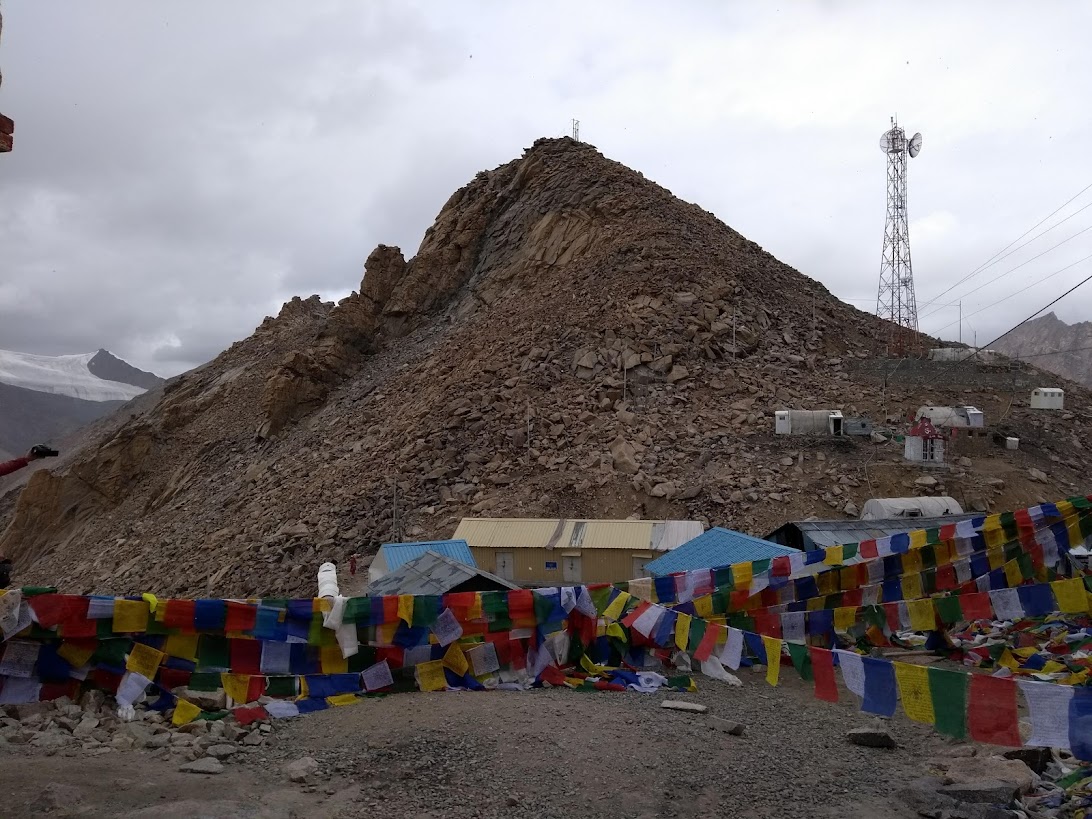
It was snowing (very mild) and within the first few minutes altitude hit me and I started feeling dizzy. I parked myself on a rock for about 5 minutes and then started walking slowly towards K-top. That’s when it hit me Kya main Khardungla Challenge kar paoonga? (Will I manage doing Khardung La Challenge?)
I kept walking and running to reach Khardung La Top and then continued the downhill run. I did about 5kms in 55 minutes and was done for the day.

A few other things that I found challenging in the run was dust in the air and diesel exhaust from vehicles and road construction equipments. My lungs were choked and my nose started bleeding.
September 04- Bhaag Bhaskar Bhaag!
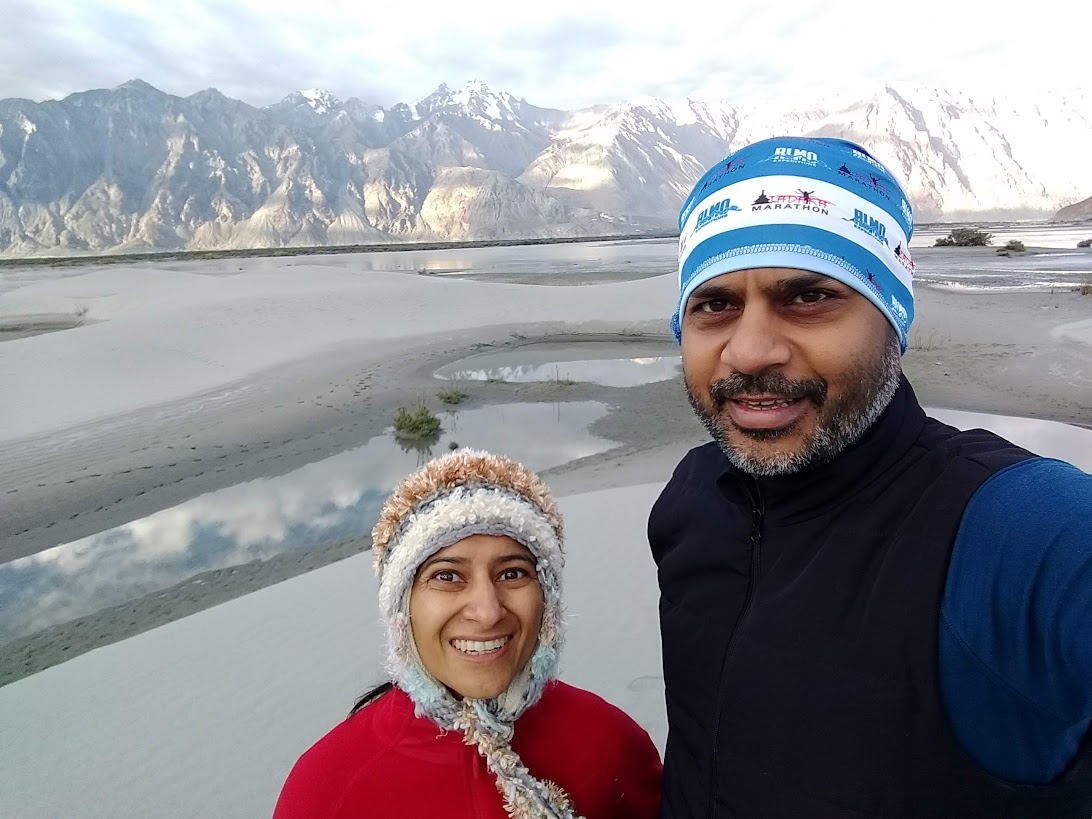
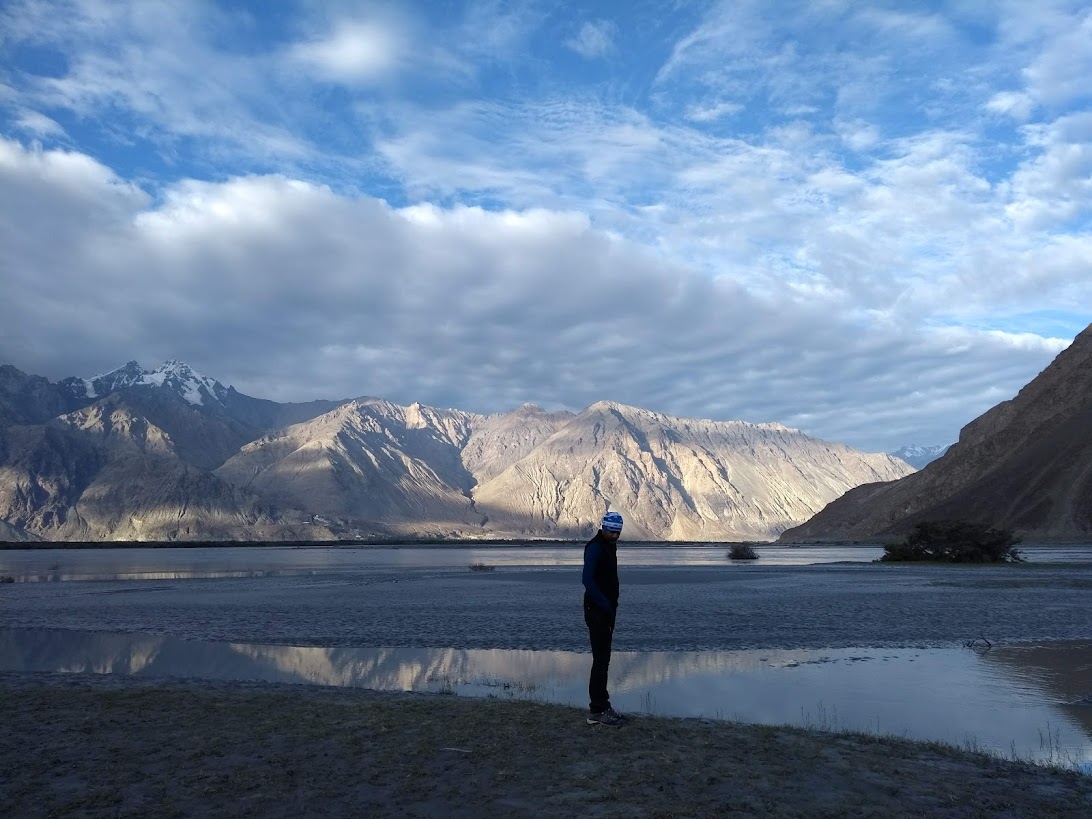
I woke up feeling much better at Nubra and visited the Diskit Monastry and sand dunes. Disket monastry has such energies that I could feel the vibrations within minutes of closing the eyes.

On the way back from Diskit we came across a dune which had large hordings ” shooting location for Bhaag Milkha Bhaag” and that set up the tone for the day’s training. On our way back to Leh I got off the car about 6kms after Khardung village and started to run up the incline.
I ran up about 7kms in an hour and felt pretty good. At the end of the run I felt ” Bhaag Bhaskar, Khardung La ho jayega!” – Run Bhaskar, Khardung La is possible!

Enroute to Leh, we stopped at Mendhak Mor– the last cut off point for the Khardung La challenge. I wanted to say Jullay! to the cute Frog and get his energy for the race.

September 05- Carb up, dress rehearsal & recce.
This was a fun day. Got up late, checked my gear- shoes, hydration bag, gels etc. and got into the 4 layers I was planning to run in. As soon as I was fully ‘dressed up’ I started feeling dizzy as it was about 25 degrees in Leh and 4 layers, gear and food together weighed about 7kg.
Once the equipment check was done we headed to The Tibetan Kitchen. Carb loading is the most interesting part of running. We had awesome Tibetan fare.
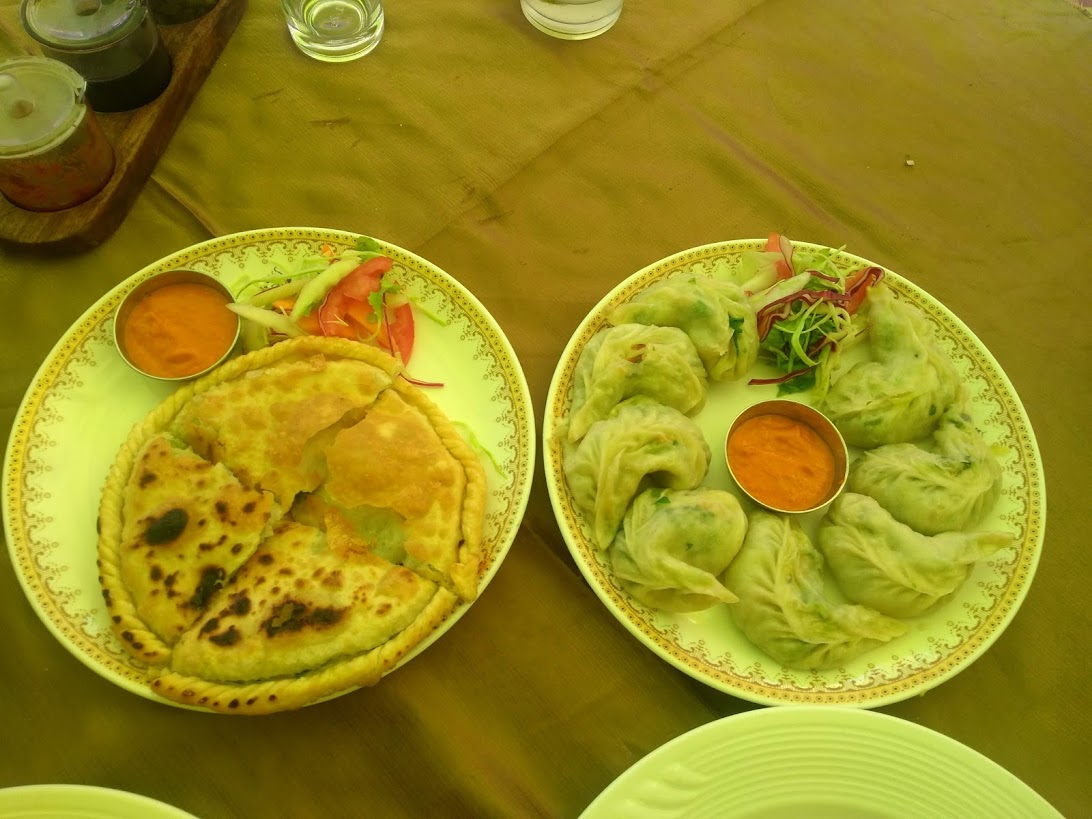
After the lunch we reported at Ladakh Marathon hub for race briefing and recce.
Ladakh marathon team organizes recce of the last 5kms route every year. This stretch is winding streets in the city and organizers do not want the runners to get lost and lose time after they have run 67 kms.

At the briefing Motup said something that I believe every runner should live by ” Khardung La will remain for ever, Khardung La Challenge will remain for years, listen to your body.”
Khardung La Challenge- the run
September 06- The Khardung camaraderie.
Khardung La Challenge is a point to point race. The organizers transfer the runners from Leh to Khardung village a day prior to the run.
I reported at the Ladakh Marathon Hub at 9:30 AM, there was a roll call at 10:00 AM and we boarded the buses to Khardung (We were on Bus 21). I met some amazing runners in the bus. I knew few runners like Nakul Girdhar, Sunil Dogra from earlier events and made some new friends like Kapil Nayyar, Anshul Agrawal, Manan, Hardik and more.
At Khardung village the Ladakh Marathon team had organised home stays- this is a very nice was to to get the locals involved with the event. I shared the room with Sanjay Chikara and Raj Prajapat. Sanjay was not feeling well and it seemed altitude hit him.

I had couple of cups of “local tea” – amazing salty Ladakhi tea to get over the bus ride fatigue and then went for the health check-up. The villagers also organized a cultural program and it was super cute to see the tiny school kids perform. Eventually, the organizers got the runners to jig.
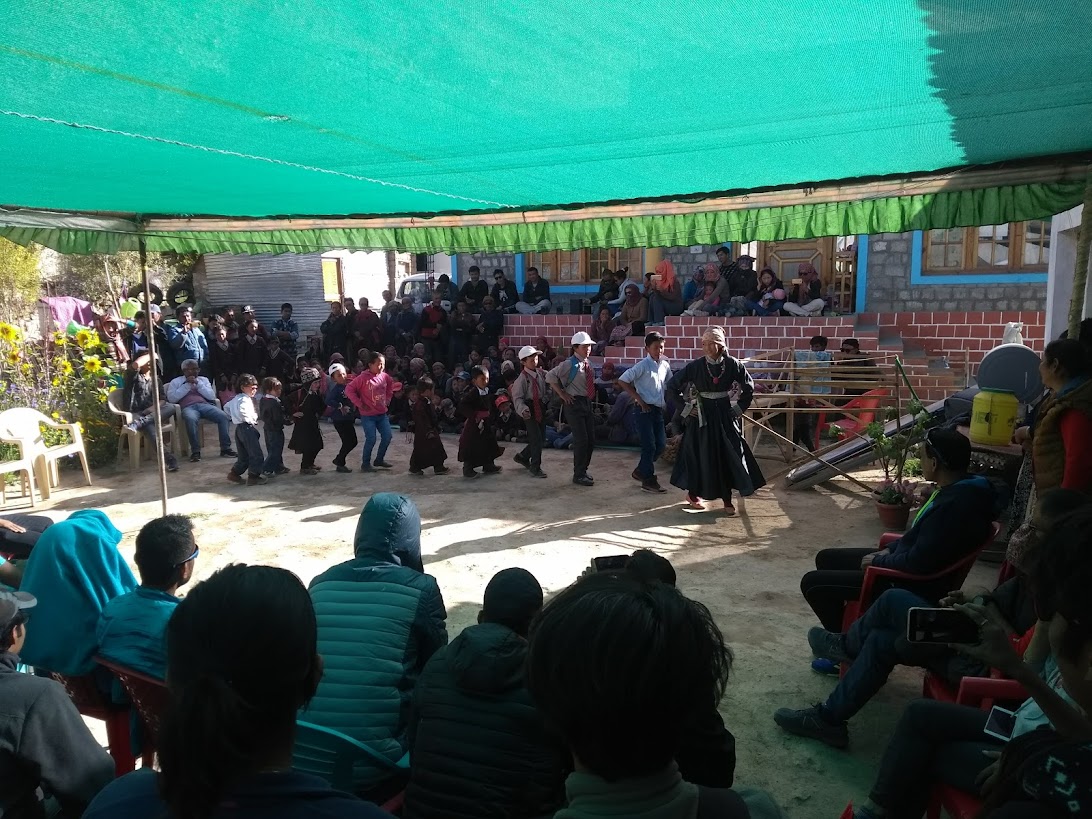
This was followed by pre-run dinner at 7:00PM. Dinner was lavish with soup, starter, salad, Indian vegetarian and non- vegetarian, pasta and more.
This was also the time to meet fellow runners and exchange notes. The day created positive vibes and a great camaraderie among runners.
By 9:00PM we had put our gears out for the morning and it was lights off.
September 07- The run.
With training and acclimatisation done it was time for the run. I was feeling fit and ready for the challenge. However, I was still recovering from the knee injury and downhill was going to be challenging.
At the start line my target was to finish the run under 12 hours. I had planned my run in three parts:
- First 32km – Khardung Village to North Pullu to Khardung La Top: My target was to run this section 5 hour 30 minutes (with 4 layers) . Take a 5-10 minute soup, layering off and bio break at K- Top.
- Next 16km – Khardung La Top- Top to South Pullu: This section has unpaved road. I was targeting to run this section in 2 hour 30 minute and taking a 10 minute layering off break at South Pullu.
- Last 24km – South Pulu to Mendhak Mor to Leh Market: I planned to do this section is 3 hours and it is all down hill and good road.
However, things did not go as planned. Here’s my account and analysis of my run:
First 32km – Khardung Village to North Pullu to Khardung La Top
I got up around 1:30am, put on my gear and at 2:30am headed to the baggage drop after wishing Sanjay and Raj good luck. It was an amazing breakfast spread at 2:45am.
However, I am not comfortable with solid food too close to the start of the run and skipped the breakfast.
Start line was buzzing with Ladakhi scouts leading the pack, ready to set the road on fire. Other runners were charged up and ready to take on the challenge. Head torches were adding to the stars on the Ladakhi skyline. I felt honored to share the space with 135 quality runners.
At 3 AM headman of Khardung Village Mr. Tsewang Norphel and DSP Suraj Singh of Leh flagged off the run.
After the first 30 minutes the runners spread out. I was enjoying my run at a 8-9 minute/km pace as planned. The first 10km of the route is relatively flat and very runnable. I could have pushed myself a little harder.

There was a news among runners about a rockslide ahead however, nothing alarming.
About 2 hours into the run it started to rain, it took me about 10 minutes pull out the poncho from my hydration bag and put it on; by that time I was all wet and was feeling cold. I continued to push on however, my pace dropped to 10-11 minute/km.
By the time I reached North Pullu my hands were frozen, I could not even open the water bottle. I asked the army contingent at North Pullu aid station to switch off my head light and help me with a gel. They offered medical help however, I wanted to push on and reach K-Top.
I continued running toward K- Top at 10 minute/km. Nature had other plans for the day- very soon, the rain droplets were snow flakes. I was wet, my hands were frozen and now I was running in the snow. The slush from the rain and snow made the unpaved road from North Pullu to K-Top more challenging. I was treading very carefully.

I finally reached K- Top in 6 hours 04 minutes– wet and 30 minutes behind plan. My hands and feet were frozen and swollen- and I could not take the gloves off. The aid station folks mentioned that the temperature is around -15/ -18 degrees. I could feel the chill in my bones, I had a bowl of hot soup and did not think it made sense to de-layer at K-Top and continued toward South Pullu in full gear.

Next 16km – Khardung La Top- Top to South Pullu
Khardung La Top to South Pullu is unpaved and downhill. I had planned doing this section at a pace of 8-9 minute/km.

It was too cold, I was wet and my limbs were frozen. I tried running down from K-Top however, I could not. It was foggy and the best I could do for the next 15 minutes is run- walk at 11-12 minute/km pace.

The clouds cleared and there was warm sun. I tried to get my pace up however, I could not, I was still cold. I kept going at run- walk at 11-12 minute/km pace.

The sunshine was short lived, before I could dry up the weather changed. It started raining again.
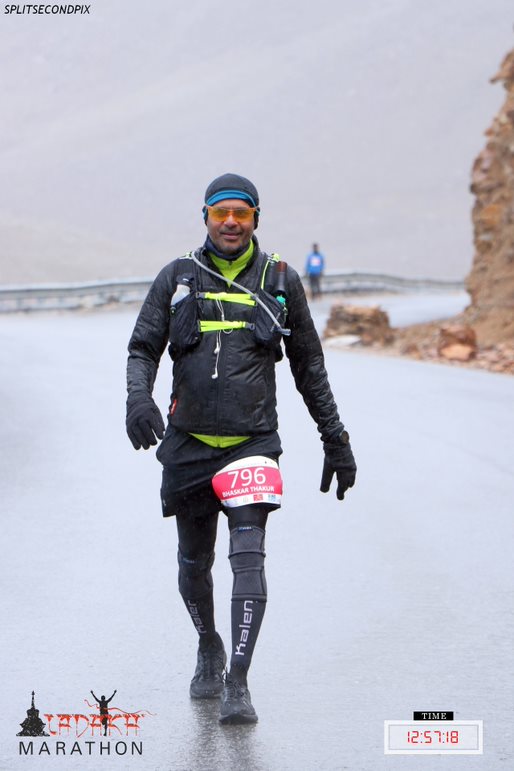
As I was approached South Pullu I was feeling very low and was mostly power walking. I kept dragging myself to South Pullu and DNF looked like a possibility.
It took me 3 hours to reach South Pullu and I was wet. When I was at the aid station another runner came in, he had de-layered at K- Top and was shivering and asking for a dry T-Shirt. I wanted to help however, there’s not much I could do.
From South Pullu I could see clouds over Leh and had to decide if I wanted to de-layer. I was wet and the jackets were heavy. I decided to take my chance and de-layer. I took off 2 layers, gloves and the warm cap. I even unloaded first aid and head light from my hydration bag. I was feeling lighter but colder.
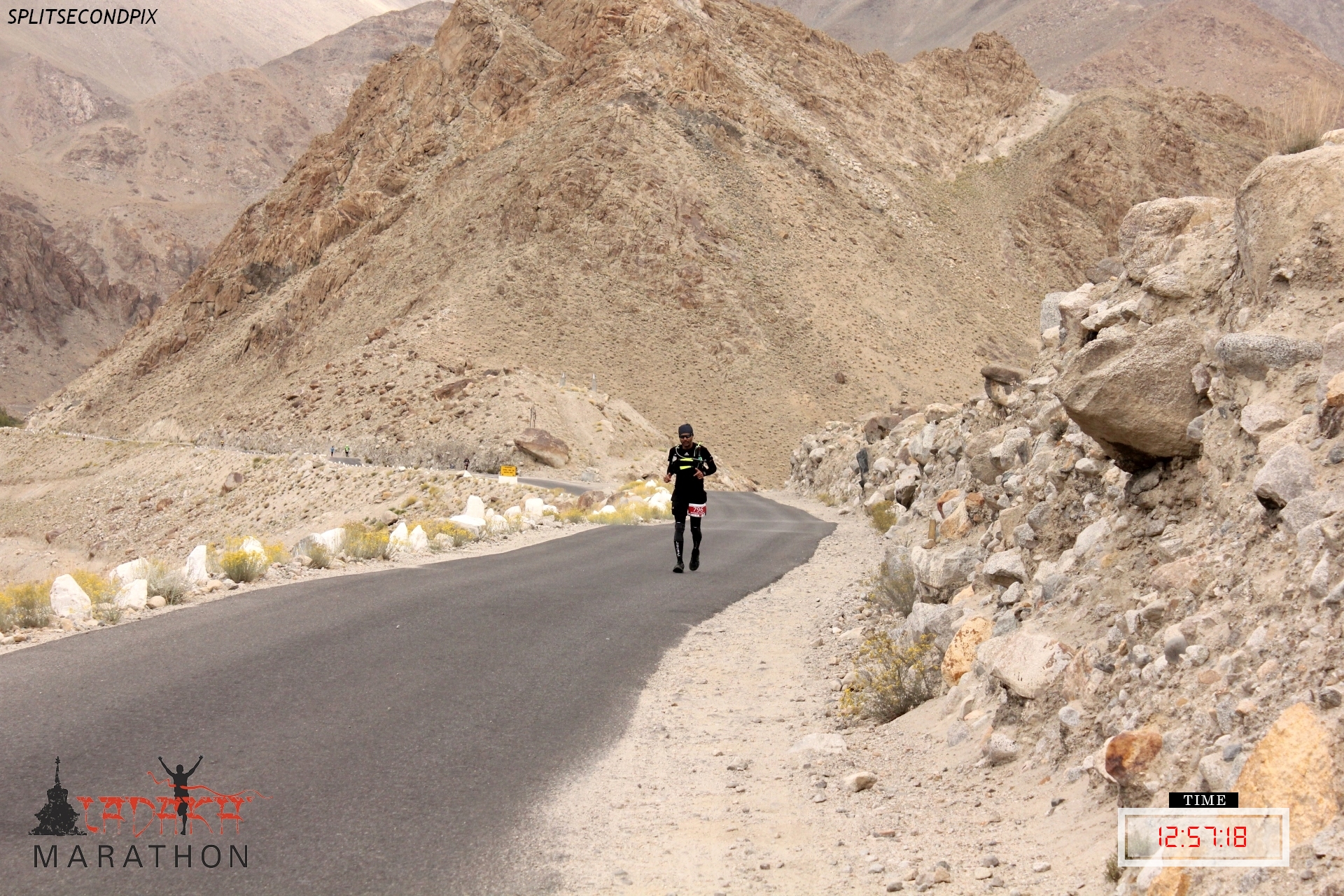
Last 24km – South Pulu to Mendhak Mor to Leh Market
I started running- walking after South Pullu and soon I was doing average pace of 9 minutes/ kilometer. The bet to de-layer paid off as it did not rain to the finish point. However, I my hands and feet were frozen and I could not improve my pace despite putting effort. I also missed my hourly nutrition as my body was rejecting food.

Cyclists started escorting runners as we entered Leh and it was nice to have some one to speak with- abouth Ladakh, Leh and their school.

I ran- walked to Leh and then to the market finishing the run in 12 Hours 57 Minutes. I took an hour more than planned however, no regrets, the weather was way out of my comfort zone.

“Khardung La will remain for ever, Khardung La Challenge will remain for years, I will return someday.. stronger.”
It was great to finish Khardung La Challenge with my dear friend Amit Sareen.
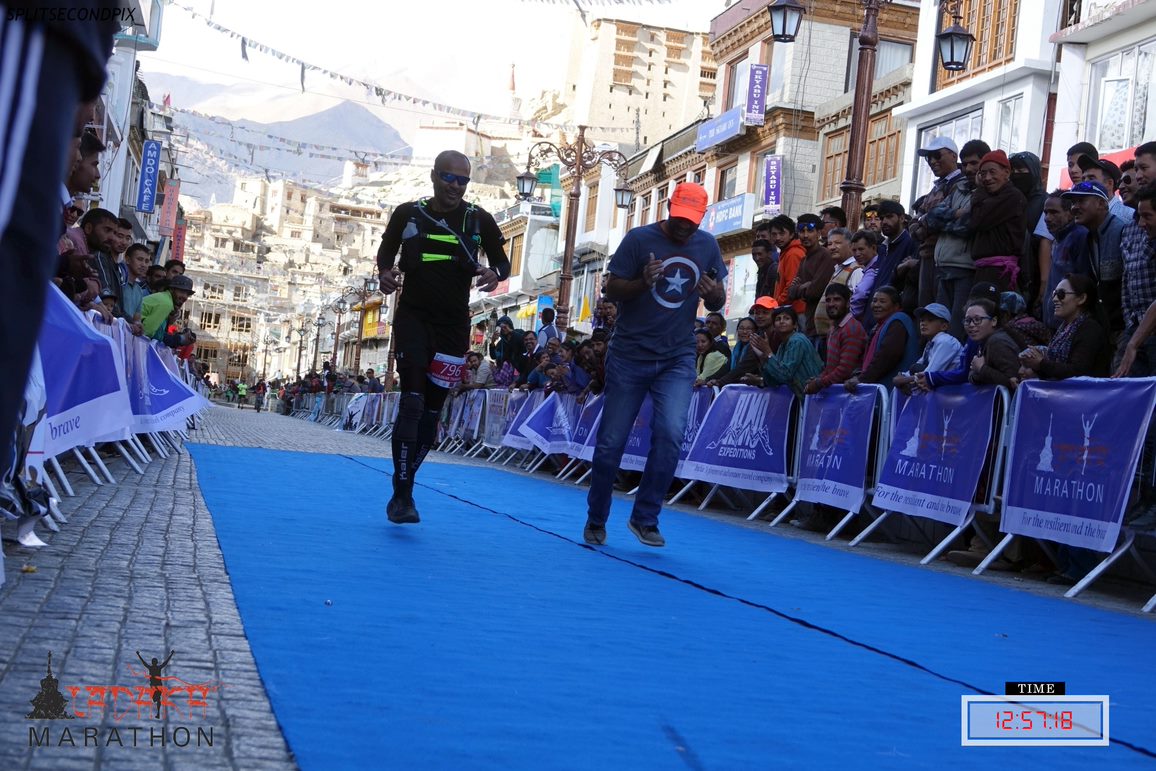
Across the finish line it was an honor to receive the Khata and meet a new fried Dorje Angchuk.

Running notes to self
There’s nothing I could have done better in the first 2 sections of the route (from Khardung village to South Pullu) however, I could have done the last section 30 minutes faster. Here’s action items to improve my running:
- Strengthen knees- work on down-hill techniques.
- Train running faster when super tired.
Bonus
36 Hours after finishing Khardung La Challenge I laced up and reached the start line of Ladakh Half Marathon. I was tired but there was more running in Ladakh. I met Amit Sareen and his running buddies from Mumbai.

Ladakh Half Marathon is a spectacular. However, I will skip the details for another blog. I took it easy and finished the run in 2:32.

Thank you the mountains of Ladakh for the showering your energies and helping me take on Khardungla Challenge! Feeling Blessed!!

I will return soon till then Jullay! Kabhi Nahi Bhuley!!
Here’s my run on Strava.